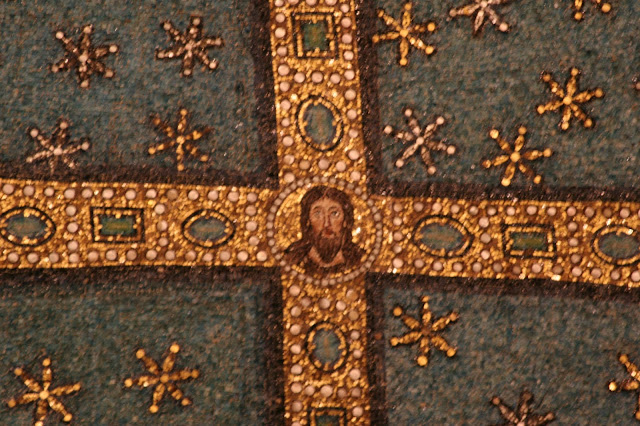 |
| Apse mosaic: S. Apollinare in Classe, the port town of Ravenna, 6th century. |
 |
| The Transfiguration |
 |
| Moses |
 |
| Elijah |
 |
| Cameo of Christ at the center of the cross |
 |
| The Hand of God |
This image from the 6th century is a powerful translation of the Gospel passage from last Sunday, choosing what appears to us as an unusual depiction of Jesus transfigured.
The lower part of the mosaic depicts St. Apollinaris (notice the spelling in the mosaic is different "Apolenaris") with twelve sheep. Apollinaris, by tradition, was the first bishop of Ravenna, assigned by St. Peter. He is depicted leading his flock (the same number as the disciples of Jesus). He was finally martyred (5th or 6th attempt) at Classe, a suburb and port to Ravenna.
The three sheep in the upper part of the apse represent Peter (alone), James, and John. In the early Church the disciples were often depicted as sheep (followers), sometimes joined by the Lamb of God (see Sta. Maria in Trastevere and SS. Cosma e Damiano in Rome). Moses and Elijah are identified with captions above them. It is interesting for us as who have had our image of Moses set by Charleton Heston in "The Ten Commandments" to have Moses depicted as such a young man (no beard). Our Gospel reading from Luke tells us that "his face changed in appearance and his clothing became dazzling white." Clearly the artist(s) did not have in mind a literal rendering of the story. In fact the depiction is of the meaning. The early Church was still not entirely comfortable with depicting Jesus crucified. The image of the jeweled cross focused on the glory that came through death in resurrection, which was the point of the Transfiguration: to show the disciples where the death he spoke about (and they had difficulty accepting). Moses and Elijah speak to him of the exodus (like that of the Jews from Egypt) that will end in glory, but not without suffering. It is interesting that in an Old English poem "The Dream of the Rood," from the 8th century, the True Cross is spoken of in its reliquary of gold, silver and precious stones. Here we see the Cross glorified. Note from the enlargement that there is a bust of Jesus in the center of the Cross, just in case you were not sure. Jesus will be transformed through his death on the Cross, just as we are called to endure our own crosses and exodus so that we might be transformed. The Gospel says "they entered the cloud." The mosaicist(s) interpreted it to mean Jesus, Elijah, and Moses, even though it sounds as though it includes the three disciples. The hand of God reaches from the heavens to identify his chosen Son, instructing the disciples to listen to him, just as they have listened to the Law (Moses) and the Prophets (Elijah). Jesus will lead them where they need to go, Apollinaris led his flock through death to life, and Jesus continues to show us the way.
No comments:
Post a Comment